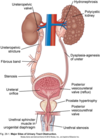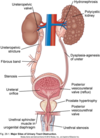Exam 4 Mon 4.4. Kidneys.Part 2 Flashcards
Big picture concept: what does the renal system regulate?
Blood Pressre
Mechanisms by which urine travels to lower urinary system?
peristalsis
What happens to prostrate as men age?
hypertrophies and can compress on urethra. Men may have difficulty urinating- spurts or slowed irregular stream
6 changes in Kidneys that occur with aging
(Great, another thing to look foward to)

- Gradual ↓ in blood flow and # of nephrons
- Less efficiency in removing waste, volume of urine ↑
- Greater risk for hyponatremia, affecting muscular efficiency/strength
- Urine production shifts to night > age 60 (daytime production in younger population
- Neurological issues will affect continence
- Multiple medications affect kidney function
Are renal carcinomas common?
No. Rare
Only 3-4% of all cancers
Points re: screening for renal carcinoma (5)
- If working with elderly population, initial screening questions should include urinary function, in addition to unusual weight loss, fatigue, etc.
- Dr. T said to screen age 50+
Look for:
- Unexplained abdominal, flank, or back pain
- Cough or pulmonary systems (RCC mets to sternum)
- Scarring/loss of tissue mobility/postural changes post-op
Information about renal carcinomas
- Most common is renal cell carcinoma (RCC), usually presenting with flank pain, hematuria, palpable abdominal mass
- May be silent in early stages, metastatic disease seen in 25-30% of cases at first diagnosis
- Surgical intervention and chemo (high dose interleukin-2)
- Variable prognosis
- Wilm’s Tumor (nephroblastoma) – most common in children, seen in first 6 years of life (500 cases/yr in U.S.)
- May be seen with some hereditary syndromes
- Nausea & vomiting, abdominal pain, malaise, loss of appetite, hematuria
- 5 year survival is 92%
How many categories of renal cysts are there?
6
What is the leading cause of ESRD, requiring dialysis and transplantation?
polycystic kidney disease (PKD)

True or false: There is no genetic component to polycystic kidney disease (PKD)
False.
There is a genetic component
Signs/symptoms and associated increased risks with polycystic kidney disease (PKD)
- ↑ risk for hypertension, UTI, cerebral and aortic aneurysms (weakness in kidney walls and also arterial walls)
- Same S/S of other kidney disorders, but kidney is greatly enlarged
Points Dr. T made about UTIs (7)
- very common, all ages
- Urethritis (UTI in urethra)
- Cystitis (UTI inbladder)
- Clinical manifestations may include ipsilateral lumbar/shoulder pain
- Screen should include questions about urination patterns and quality of urine
- May see fever/chills, malaise, anorexia, mental status changes (frequently in the elderly)
- many hospital admissions find UTI as base cause

Points Dr. T made about Pyelonephritis (3)
- frequently a sequelae of a UTI
- In addition to above S/S, pain at costovertebral angle (Murphy’s sign)
- Chronic infection may cause scarring, eventually lead to ESRD

4 possible locations for upper urinary tract obstructions
- ureter
- renal pelvis
- calyces
- renal parenchyma

What is Hydroureter?
urine accumulates at level of ureter

What is Hydronephrosis?
urine accumulates above the ureter

5 causes of obstruction
- compression from inflammation related to infection
- stones
- stenosis of urethra (long term indwelling catheter- think SCI as example)
- problems with sphincter muscles
- Problems at valves in the tract
If you retain more than 30ccs of urine in your bladder after emptying it, what can happen?
bladder infection
Want to completely empty- very important for SCI
5 types of incontinence
- Urge incontinence
- Stress incontinence
- Overflow incontinence
- Mixed
- Functional
A bunch of things to know about kidney stones AKA Calculi including symptoms (12)
- Calculi – mineral deposits that form inside kidney
- Come in variety of shapes and sizes
- Severe pain, unilateral, in the side and back, below the ribs, groin, abdomen
- Murphy’s percussion test usually positive
- Pain that comes in waves and fluctuates in intensity
- Pain on urination
- Pink, red or brown urine; cloudy or foul-smelling urine
- Nausea and vomiting
- Persistent need to urinate
- Urinating more often than usual
- Fever and chills if an infection is present
- Urinating small amounts of urine
Important to note about taking calcium supplements
Too much calcium can build up in the kidneys and form kidney stones. Should consult doc and what is teh best dosage for you.
Methods for detecting kidney stones (4)
- Intravenous Pyelogram (IVP)- dye injected into vein then x-ray taken
- KUB Radiograph (kidney, ureters, and bladder) and ultrasound
- Kidney Color Doppler
- CT scan
Methods for breaking up the kidney stone (2)
- Ureteroscopy- upper urinary tract endoscopy performed most commonly with an endoscope passed through the urethra, bladder, and then directly into the upper urinary tract.
- Lithotripsy- using ultrasound shock waves, by which a kidney stone or other calculus is broken into small particles that can be passed out by the body
Basic definition of chronic kidney disease
Alteration of kidney function/structure for ≥3 months
3 most common causes of chronic kidney disease
- Diabetes (metabolic syndrome)
- Hypertension
- Glomerulonephritis
Analgesic nephropathy
- a caution for people taking OTC meds such as Goody’s or BC powders (aspirin-phenacetin-caffeine), Tylenol, aspirin
- NSAIDS have more short-term than long-term effect, moderate use considered safe
- Phenacetin is super bad for the kidneys
- NSAIDS that are 1 a day do not clear as quickly and is something to think about with regards to long term effects on kidneys
- Tylenol is worse for kidneys
* in the chronic kidney disease pp
Final stage of chronic kidney disease
End stage renal disease
*•More than 20 million in U.S. have CKD
There are 5 stages of chronic kidney disease
True or False: Both stage 2 and 3 have GFR <30ml/min
False
Both stage 4 and 5 have GFR <30ml/min
What is going on during stage 1 of CKD (chronic kidney disease)?
- kidney damage
- normal or slightly elevated GFR
- May be asymptomatic, or show HTN, anemia
- may be reversible
What’s going on during stage 2 of CKD?
- kidney damage with mildly decreased GFR
- May see albumin in urine
What’s going on during stage 3 of CKD?
- •moderately decreased GFR
- ↑ creatinine and BUN (azotemia)
What’s going on during stage 4 of CKD?
- severely decreased GFR,
- Systemic complications
- ↑ proteinuria, BUN, creatinine, renin
- HTN
What’s going on during stage 5 of CKD?
- kidney failure, ESRD
- Uremia, kidney cannot excrete toxins
- S/S include nausea, vomiting, lethargy, pruritis, neuropathy, pericarditis, asterixis (“flapping sign”)
- Dialysis required
systemic manifestations of kidney failure (9)
- Urinary
- Cardiopulmonary
- GI tract- nausea, vomiting, anorexia
- Nervous system- neuropathy (some stocking and glove), mental status
- Integument- slow wound healing, itchy
- Eyes- retinopathy
- Endocrine- aldosterone is inhibited, feedback loop is screwed up
- Hematopoietic system- EPO is produced
- Skeletal system- osteoporosis, weak bones, affects calcium balance
More specific Musculoskeletal Complications with CKD (7)
- Osteomalacia (vitamin D deficiency, softening)
- Bone pain
- Demineralization
- Calcification of vessels and soft tissues due to deposition of calcium
- Also responsible for skin itching
- Calcification of tendons, articular cartilage
- Myopathies and weakness
More specific Neurological Complications with CKD (3)
- Sleep disturbances, memory loss, perceptual errors, confusion
- Peripheral sensory and motor neuropathies
- Restless leg syndrome (corollary finding)
Points on exercise and CKD (9)
- Need strength, balance, mobility/endurance
- Will require longer course of PT to achieve goals; studies cite 12 week interventions
- Exercise at 40-70% of target heart rate, with adequate warm-up and cool-down periods
- ↑risk for cardiac events, especially if coupled with DM
- Autonomic dysfunction may limit max predicted HR by 20-40 bpm
- Use rate of perceived exertion (RPE) as guideline for exercise
- Goals should be aimed at maintaining or improving quality of life
- Exercise may exacerbate co-morbid conditions
- Monitor BP, glucose, pulse, PRE, O2 sat, BUN, creatinine (G&F, Table 40-2, p. 1640)
Points on exercise and CKD, but specific to dialysis (3, kinda 4)
- If on dialysis, will need to assess impact of dialysis on schedule and patient’s physical ability
- In theory, blood chemistries will be at peak right after dialysis – patient usually very fatigued, and blood glucose will be variable
- As electrolyte imbalance is least stable on day prior to renal dialysis, plan for exercise on day of/day after
- This is not likely problematic with peritoneal dialysis, but do want to plan exercise when abdomen is empty, if possible
Two important lab values to monitor when kidney stuff is going on
- BUN
- Creatine
Things to know about BUN

- BUN ↑ when renal function ↓, indicates ↓ renal blood flow
- May also show protein breakdown or ↑dietary protein, GI bleed (another source of protein breakdown)
- Liver disease can alter these numbers
Things to know about Creatine
- Creatinine directly correlates with glomerular filtration and nephron damage
- Normal product of skeletal muscle regeneration, so should be a constant if kidneys are functioning correctly
- Can also be a sign of muscle damage (rhabdomyolysis)
- Abnormal values can also be seen in aging or with acute kidney disease
Glomerulonephritis a group of diseases that manifest with hematuria
Name the 4 outlined in the slide
- Acute glomerulonephritis
- Rapidly progressive glomerulonephritis
- Chronic glomerulonephritis
- Nephritic syndrome (blood in urine)
What is Nephrotic Syndrome?
- glomerular injury
- excretion of 3.5g or more of protein in urine/day
What is Nephritis Syndrome?
diseases causing hematuria
PT precautions for Glomerular Disorders
precautions for these patients include potential side effects (diuretics, muscle cramping), exercise precautions as noted previously
What is hemoialysis?
a machine filters wastes, salts and fluid from your blood when your kidneys are no longer healthy enough to do this work adequately.
What is Peritoneal dialysis?
- another way to remove waste products from your blood when your kidneys can no longer do the job adequately.
- During peritoneal dialysis, blood vessels in your abdominal lining (peritoneum) fill in for your kidneys, with the help of a cleansing fluid that flows into and out of the peritoneal space.
- Done at home. Only people who are capable of being very sterile.
- Person will have line installed into body.
- Can be interrupted- benefit for bathroom use.
- Can do in multiple short bursts or overnight
What is a hemodialysis fistula?
- A vascular access is a surgically created vein used to remove and return blood during hemodialysis.
- An arteriovenous (AV) fistulais a connection, made by a vascular surgeon, of an artery to a vein.
- Have to wait longer to use fistula but it last longer. This is preferable.
- It uses body part so rejection is less likely to happen
- Fistulas are usually done distally so that if dialysis continues and it becomes unusable then will make a proximal fistula.
Option besides a fistula in the arm
- graft
- don’t need to wait as long, but also does not last as long


